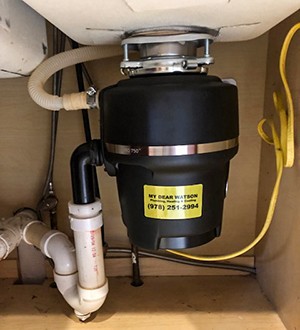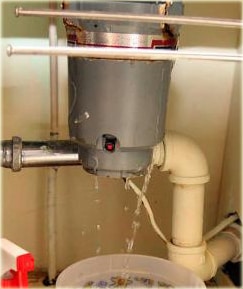We've discovered this article involving Garbage Disposal Leaking From Bottom directly below on the internet and think it made good sense to talk about it with you in this article.

Waste disposal unit are necessary kitchen area devices that aid in disposing of food waste effectively. Nevertheless, a dripping garbage disposal can be an irritating and untidy problem to take care of. The good news is, numerous leaks can be taken care of quickly with a few basic actions. In this write-up, we will certainly review how to deal with a leaking waste disposal unit efficiently.
Intro
Garbage disposals are set up under cooking area sinks and are developed to shred food waste into smaller sized pieces, allowing it to pass through the pipes system quickly. While these gadgets are generally trusted, leakages can occur with time because of wear and tear, loosened connections, or damages to the system.
Step-by-Step Overview to Taking Care Of a Dripping Waste Disposal Unit
Switch off the Power
Prior to attempting any kind of fixings, ensure that the power to the waste disposal unit unit is turned off to prevent the threat of electric shock.
Find the Leakage
Identify the precise area of the leak and determine the cause
Tighten up Links
Use a wrench to tighten any type of loosened links between the disposal unit and the plumbing system.
Replace Seals or Gaskets
If the leakage is due to worn seals or gaskets, eliminate the old components and replace them with new ones.
Patching Cracks or Holes
For cracks or holes in the disposal unit, use epoxy or a suitable patching product to secure the damaged area.
Identifying the Source of the Leak
Prior to trying to deal with a dripping garbage disposal, it is vital to recognize the resource of the leak. This can usually be done through aesthetic examination or by carrying out easy tests.
Visual Examination
Check the waste disposal unit system carefully for any kind of indications of water leak. Pay very close attention to areas around seals, gaskets, and link points.
Checking for Leaks
One means to test for leakages is by running water with the disposal device and checking for any kind of visible indications of leakage.
Usual Root Causes Of Leaks in Waste Disposals
Worn Seals and Gaskets
Seals and gaskets play an essential duty in avoiding water from leaking out of the waste disposal unit. Over time, these parts can deteriorate, resulting in leakages around the disposal device.
Loose Links
The links in between the garbage disposal and the plumbing system can end up being loose in time, causing water to leakage out throughout operation.
Cracks or Openings in the Disposal Unit
Physical damage to the garbage disposal, such as splits or holes in the real estate, can likewise cause leakages.
Devices and Materials Needed for Dealing With a Leaking Waste Disposal Unit
Before beginning the fixing process, gather the needed tools and materials, consisting of a screwdriver, flexible wrench, plumbing's putty, substitute seals or gaskets, and epoxy or patching material for repairing splits or openings.
Checking the Waste Disposal Unit After Fixing
When the repair is full, examine the waste disposal unit by running water via it to make certain that the leakage has actually been settled.
Preventive Upkeep Tips to Avoid Future Leaks
To prevent future leakages, it is vital to do normal maintenance on your garbage disposal. This includes maintaining it tidy, avoiding placing non-food items or difficult items down the disposal, and regularly looking for leaks or various other concerns.
Verdict
In conclusion, repairing a dripping waste disposal unit is a relatively uncomplicated procedure that can be completed with standard devices and materials. By complying with the steps described in this short article and practicing preventive upkeep, you can maintain your waste disposal unit in good working condition and prevent pricey repair work in the future.
What to Do About a Leaking Garbage Disposal
A leaking garbage disposal often goes unnoticed until you confront a sopping cabinet, a foul-smelling puddle, or an audible drip-drip-drip from the unit. The fix can be frustrating, too, because the leak can stem from a number of components in the system. Fortunately, with a little sleuthing, you can zero in on the leak and—depending on the exact location—stop the icky oozing and repair the component that caused it. Worst case scenario, if it turns out that the garbage disposal must be replaced, installing a new one is a reasonable do-it-yourself task for those with basic plumbing skills. Read on to keep the cash you’d otherwise hand over to a pro.
Prepare to find the leak
Prior to testing the garbage disposal for leaks, unplug it at the wall outlet and turn off the power from the breaker box to prevent electrical shock. Then insert a watertight sink stopper into your sink drain and wipe the unit dry with a clean cloth. In any handy container, mix a few drops of food coloring into a few cups of water, and pour the dyed water onto the sink stopper to help you locate the leak.
Investigate the source
the top, where the disposal meets the sink drain the side, where the dishwasher hose or main drain pipe connects to the disposal or the bottom of the unit Inspect each of these locations while gliding a light-colored rag over the unit; the dyed water will readily show on the rag and reveal the location of the leak. If a leak isn’t immediately apparent, remove the sink stopper and pour a few more cups of dyed water down the sink drain, then check for leaks again. Leaks near the top of the unit are more likely to show themselves while the sink is plugged, while side and bottom leaks are more noticeable while the sink is unplugged.
The metal sink flange that sits directly inside the sink drain is typically sealed around the top with plumber’s putty (a clay-like sealant) and then secured from under the sink with bolts. If the plumber’s putty deteriorates, or the bolts loosen, the flange can no longer form a watertight seal between the sink drain and the disposal—which could cause a leak at the top of the unit.
To reseal the leaky flange, you must first detach the garbage disposal. Start by loosening the screws securing the main drain pipe to the disposal, then loosen the screws in the metal clamp securing the dishwasher hose to the disposal and detach the drain pipe and dishwasher hose from the disposal. Loosen the screws in the mounting ring that connects the disposal to the metal mounting assembly beneath the sink, then pull down the disposal and carefully set it on a clean, dry surface. Loosen the bolts in the mounting assembly with a wrench, then pull down the mounting assembly and set it near the disposal.

As a fervent reader on Garbage Disposal Leaking From Bottom, I think sharing that short article was a good thing. Feel free to take the time to share this blog if you enjoyed it. We love reading our article about Tips on Fixing a Leaking Garbage Disposal.
Call Today